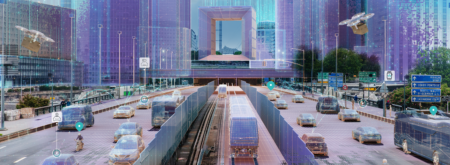The UK Government has announced its intention to facilitate digital twins for all modes of transportation by 2035, in its recently published TRIB Transport Digital Twin Vision and Roadmap to 2035.
Optimising traffic flows, providing live updates on EV chargers, and reducing infrastructure maintenance are just three ways in which digital twins are set to revolutionise transport, all of which can help reach ambitious targets for achieving net zero.
The new roadmap details the steps required to deliver the vision for connected digital twins across four key areas: strategy and innovation; enabling environment; people, skills and culture; and technology and data. It will be a tool for engagement and alignment around common strategic priorities.
The Roadmap aims to: “Enable a trusted ecosystem of connected digital twins for multi-modal UK transport networks. This will facilitate effective decision making to optimise solutions and deliver efficient, safe, and environmentally conscious mobility for people and goods.”
The potential value of technologies like digital twins, AI and robotics increases as they start to converge to form a cyber-physical infrastructure where new products and services can be developed which can lead to the seamless connection of autonomous vehicles and transport.

As part of the Vision and Roadmap, the Department of Science, Innovation and Technology sponsored six innovative SMEs to develop use cases, illustrating the ways in which digital twin technology can provide value to the transport sector, including:
• Slingshot Simulations, which has developed a digital twin called Compass Engine to predict the impact of introducing changes to the highway network in urban areas, such as closing certain roads to reduce emissions.
• Digilab is building a digital twin called twinAir which monitors air pollution from road traffic in real time. The company has created what it calls a ‘physics informed surrogate’ for the city of Exeter that collects air quality data from the roadside. It then scales this information to provide a more accurate picture of traffic related pollution right across the city.
• OpenSpace is helping railway station operators harness digital twins to put passengers at the heart of decision-making. Its digital twin solution fuses real-time passenger detection, virtual spaces, analytics and visualisation to provide intelligence to help boost the customer experience, increase revenues and reduce costs.
Launching the roadmap, at the inaugural Connected Digital Twins Summit, hosted by Connected Places Catapult, the UK’s Transport Technology and Decarbonisation Minister Jesse Norman said: “The UK is a global leader in transport technology partnering with industry. The Vision and Roadmap for Digital Twins shows how the Department for Transport is supporting innovative digital twin technologies for a cleaner, greener and more efficient transport system.”
“Connected digital twins are well placed to deliver significant economic, social and environmental impact and drive the UK as a science and technology superpower,” says Paul Wilson, chief business officer at Connected Places Catapult and member of the Transport Research and Innovation Board. “This roadmap shows how we can go from pockets of excellence with this technology, to wider implementation across our towns and cities. Only then will we be able to realise this technology’s potential to deliver greener, multi-modal transport at scale.”





